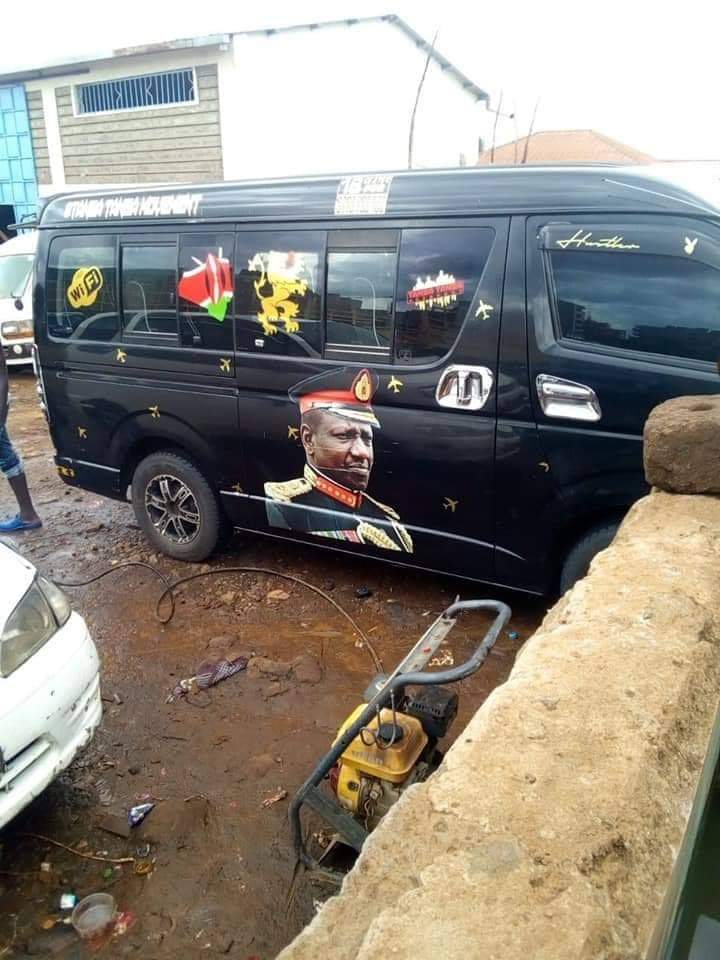Police officers acting on a tip off today arrested a Pro-Ruto MCA named Julius Macharia together with his driver, George Ngugi Kiarie.
The duo was driving a motor vehicle registration number KCQ 918U, Toyota Hiace. The motor vehicle had its body displaying portrait of the DP William Ruto in full military fatigue depicting him as the commander in chief.
It further displayed graphics of the coat of arms, national flag of Kenya. The motor vehicle has been detained at Juja police station yard awaiting photography and further investigation.
They were arraigned in court in Thika and charged with operating an unroadworthy vehicle. According to the prosecution, the Toyota Hiace had 19 instead of 16 passenger seats, tinted windows, loose passenger seats, coloured parking lights and carrying excess passengers.
The duo pleaded not guilty to the charges and were released on a sh 20,000 cash bail only to be arrested Five Minutes later after the DCI filed an application seeking to have Macharia detained for five more days over the illegal use of emblems.
Illegal use of emblems contravens section 3(a) cap 99 Laws Of Kenya of the national flag, emblems and names act.
A number of Kenyans on social media are however reading political witchhunt in Macharia’s arrest.
I don’t have time for DP Ruto but the arrest of Weitethie MCA Julius Macharia is in bad faith. The police can just tell him to remove the flag and the coat of arm from the vehicle. I doubt if it has anything to do with Ruto image. The guy was just trying to be patriotic.
— Hon Lee Makwiny (@leemakwiny) May 28, 2019
So they arrested Weitethie MCA Julius Macharia for DP Ruto pics drawn in his car!!! Raila odinga who swore himself as the President of the republic Kenya is walking scot free. 🤔🤔 Fighting Ruto won’t help Baba become a President rather it will rapture his political career. pic.twitter.com/0BnTHSbRw2
— Eric Kerong’o 🇰🇪 (@Ekerongo_) May 28, 2019
INTERPRETATION of Section 3(a) Cap 99 Laws Of Kenya of the National Flag, Emblems and Names Act (Source, http://www.kenyalaw.org)
1.
Short title
This Act may be cited as the National Flag, Emblems and Names Act.
2.
Interpretation
In this Act—
“motor vehicle”has the meaning assigned to it in the Traffic Act (Cap. 403);
“the National Anthem” means the national anthem, the words and music of which are set out in the Third Schedule to this Act;
“specified emblem” means any emblem, seal, flag, pennant, insignia, ensign or coat-of-arms of a kind specified in Part I of the First Schedule to this Act;
“specified likeness” means any photograph, drawing or other pictorial representation of the person for the time being holding any of the offices or dignities specified in Part III of the First Schedule to this Act;
“specified name” means any of the names and words specified in Part II of the First Schedule to this Act, and includes any abbreviation of any such name;
2A.
National Flag Armorial Ensigns, Public Seal and National Anthem declared
(1)
The flag of which the design and description are set out in Part I of the Second Schedule to this Act is hereby declared to be the National Flag of Kenya (in this Act referred to as the National Flag).
(2)
The heraldic device of which the blazon and description are set out in Part II of the Second Schedule to this Act is hereby declared to be the Armorial Ensigns of Kenya (in this Act referred to as the Armorial Ensigns).
(3)
The seal of which the design is set out in Part III of the Second Schedule to this Act is hereby declared to be the Public Seal of Kenya.
(4)
The anthem of which the words and music are set out in the Third Schedule of this Act is hereby declared to be the National Anthem of Kenya.
[Act No. 32 of 1964, s. 2, Act No. 15 of 1968, s. 3.]
2B.
Insulting National Anthem, etc., an offence
Any person who shows disrespect, in speech, manner or writing, to or with reference to the National Anthem, or to any specified emblem, specified likeness or specified name, or any representation thereof, shall be guilty of an offence and liable to a fine not exceeding five thousand shillings or to imprisonment for a term not exceeding six months, or to both such fine and such imprisonment.
[Act No. 32 of 1964, s. 2, Act No. 15 of 1968, s. 4.]
3.
Prohibition of improper use of emblems, names and likenesses
(1)
Notwithstanding anything contained in any law for the time being in force, no person shall, except with the written permission of the Minister—
(a)
use any specified emblem, specified name or specified likeness, or any colourable imitation thereof, in furtherance of, or display the same as an advertisement for, any trade, business, calling or profession; or
(b)
use any specified emblem, specified name or specified likeness, or any colourable imitation thereof, in the title of any patent, or in any trade mark or design; or
(c)
manufacture or import any article or goods bearing any specified emblem, specified name or specified likeness, or any article or goods on which any title, trade mark or design is used in contravention of paragraph (b) of this subsection.
(2)
The provisions of subsection (1)(a) of this section relating to the use of a specified likeness shall not apply to the publication of a bona fide news item (whether in a newspaper or by any other medium) or to the publication in a newspaper of any article connected with any bona fide news item other than a news item in the furtherance of, or as advertisement for, any trade, business, calling or profession.
(3)
Any permission given under subsection (1) of this section may be given subject to such conditions as the Minister may deem fit.
(4)
Any person who contravenes the provisions of this section shall be guilty of an offence and liable to a fine not exceeding five thousand shillings, or to imprisonment for a term not exceeding six months, or to both such fine and such imprisonment.
[Act No. 32 of 1964, s. 2.]
4.
Prohibition of registration of certain companies, etc.
Notwithstanding anything contained in any law for the time being in force, no authority empowered or required by law to register any company, firm or other body of persons, or any trade mark or design, or to grant a patent, shall—
(a)
register any company, firm or other body of persons under any name; or
(b)
register a trade mark or design which bears any emblem, name, word or likeness; or
(c)
grant a patent in respect of an invention which bears a title containing any emblem, name or word,
if the use of such name, emblem, word or likeness would be in contravention of section 5 of this Act, and any purported registration or grant made contrary to this section shall be absolutely void and ineffective for all purposes.
[Act No. 32 of 1964, s. 2.]
4A.
Flying of national flag on a motor vehicle
(1)
A person shall not fly the national flag on any motor vehicle.
(2)
Notwithstanding subsection (1), the President, the Deputy-President, the Chief Justice, Cabinet Secretaries, the Speaker of the National Assembly, the Speaker of the Senate and Diplomats, while in foreign missions may fly the national flag on a motor vehicle.
(3)
A person who contravenes subsection (1) commits an offence and shall be liable, on conviction, to a fine not exceeding one million shillings or to imprisonment for a term not exceeding five years, or both.
[Act No. 10 of 2014, s. 3.]
5.
Prohibition of display of certain flags
(1)
No person shall display at any place or on any premises any flag or banner or permit any flag or banner to be so displayed, being in either case a flag or banner (other than a specified emblem) which is reputed to belong, or is held out by any authority as belonging, to the territory of Kenya or of any particular part thereof (other than the area of a local authority).
(2)
Any person who contravenes subsection (1) of this section shall be guilty of an offence and liable to a fine not exceeding five thousand shillings or to imprisonment for a term not exceeding six months, or to both such fine and such imprisonment.
(3)
This section shall bind the Government.
6.
Sanction for prosecution
No prosecution for any offence punishable under this Act shall be instituted except with the previous sanction in writing of the Attorney-General.
7.
Power of seizure
(1)
If a police officer has reasonable cause to believe that some thing which has been used, displayed, manufactured or imported contrary to this Act is to be found on any premises, he may require the person in charge or appearing to be in charge of the premises to allow him to enter the premises and to afford him all reasonable facilities for a search thereof, and if entry cannot within a reasonable period be so obtained the officer may without warrant enter the premises (using force if necessary) and search therein.
(2)
If a police officer finds on any premises anything in respect of which he has reasonable cause to believe that an offence under this Act has been committed by any person, he may seize that thing, and where he does so shall bring it before a magistrate, who shall order it to be forfeited if he is satisfied that it has been used, displayed, manufactured or imported contrary to this Act, or else shall order it to be restored to the person from whom it was seized.
8.
Power to amend First Schedule
The Minister may, by notice in the Gazette, amend the First Schedule to this Act.
[Act No. 32 of 1964, s. 2.]
9.
Regulations
The Minister may make regulations—
(a)
prescribing the occasions upon which, the persons by whom and the manner in which the National Flag or the Armorial Ensigns may be flown or displayed, as the case may be;
(b)
prohibiting, controlling or restricting the use of any specified emblem, specified likeness or specified name;
(c)
regulating the manner in which application may be made to him for his permission under section 5 of this Act, prescribing the form of any licence by which such permission may be given and fixing any fee for such application and licence;
(d)
generally for carrying this Act into effect.
[Act No. 32 of 1964, s. 2.]


